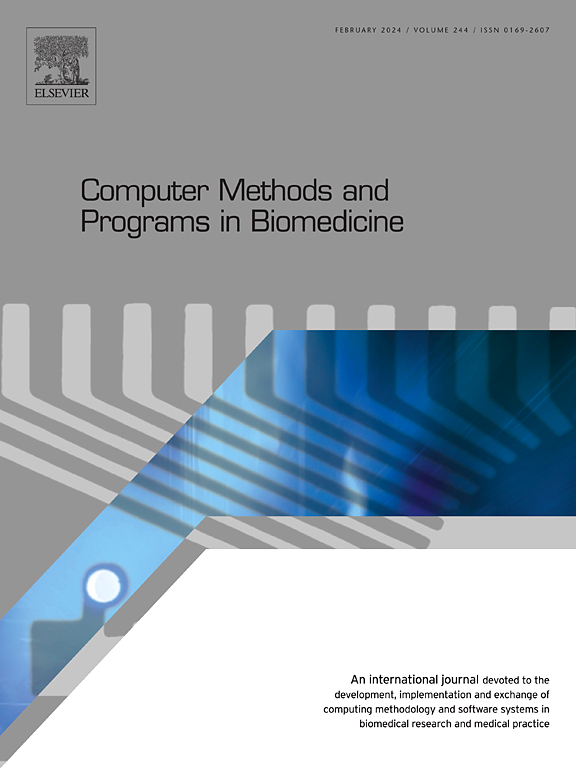Machine learning-based approaches for distinguishing viral and bacterial pneumonia in paediatrics: A scoping review
IF 4.9
2区 医学
Q1 COMPUTER SCIENCE, INTERDISCIPLINARY APPLICATIONS
引用次数: 0
Abstract
Background and Objective:
Pneumonia is the leading cause of hospitalisation and mortality among children under five, particularly in low-resource settings. Accurate differentiation between viral and bacterial pneumonia is essential for guiding appropriate treatment, yet it remains challenging due to overlapping clinical and radiographic features. Advances in machine learning (ML), particularly deep learning (DL), have shown promise in classifying pneumonia using chest X-ray (CXR) images. This scoping review summarises the evidence on ML techniques for classifying viral and bacterial pneumonia using CXR images in paediatric patients.
Methods:
This scoping review was conducted following the Joanna Briggs Institute methodology and the PRISMA-ScR guidelines. A comprehensive search was performed in PubMed, Embase, and Scopus to identify studies involving children (0–18 years) with pneumonia diagnosed through CXR, using ML models for binary or multiclass classification. Data extraction included ML models, dataset characteristics, and performance metrics.
Results:
A total of 35 studies, published between 2018 and 2025, were included in this review. Of these, 31 studies used the publicly available Kermany dataset, raising concerns about overfitting and limited generalisability to broader, real-world clinical populations. Most studies (n=33) used convolutional neural networks (CNNs) for pneumonia classification. While many models demonstrated promising performance, significant variability was observed due to differences in methodologies, dataset sizes, and validation strategies, complicating direct comparisons. For binary classification (viral vs bacterial pneumonia), a median accuracy of 92.3% (range: 80.8% to 97.9%) was reported. For multiclass classification (healthy, viral pneumonia, and bacterial pneumonia), the median accuracy was 91.8% (range: 76.8% to 99.7%).
Conclusions:
Current evidence is constrained by a predominant reliance on a single dataset and variability in methodologies, which limit the generalisability and clinical applicability of findings. To address these limitations, future research should focus on developing diverse and representative datasets while adhering to standardised reporting guidelines. Such efforts are essential to improve the reliability, reproducibility, and translational potential of machine learning models in clinical settings.
区分儿科病毒性和细菌性肺炎的基于机器学习的方法:范围综述
背景和目的:肺炎是五岁以下儿童住院和死亡的主要原因,特别是在资源匮乏的环境中。准确区分病毒性和细菌性肺炎对于指导适当的治疗至关重要,但由于临床和影像学特征重叠,仍然具有挑战性。机器学习(ML),特别是深度学习(DL)的进步,在使用胸部x射线(CXR)图像对肺炎进行分类方面显示出了希望。这篇综述综述了使用CXR图像在儿科患者中分类病毒性和细菌性肺炎的ML技术的证据。方法:根据乔安娜布里格斯研究所的方法和PRISMA-ScR指南进行范围审查。我们在PubMed、Embase和Scopus中进行了全面的检索,以确定通过CXR诊断为肺炎的儿童(0-18岁)的研究,使用ML模型进行二分类或多分类。数据提取包括ML模型、数据集特征和性能指标。结果:本综述共纳入了2018年至2025年间发表的35项研究。其中,31项研究使用了公开的德国数据集,这引起了人们对过度拟合和对更广泛的现实世界临床人群的有限通用性的担忧。大多数研究(n=33)使用卷积神经网络(cnn)进行肺炎分类。虽然许多模型表现出良好的性能,但由于方法、数据集大小和验证策略的差异,观察到显著的可变性,使直接比较复杂化。对于二元分类(病毒性肺炎与细菌性肺炎),中位准确率为92.3%(范围:80.8%至97.9%)。对于多类别分类(健康、病毒性肺炎和细菌性肺炎),中位准确率为91.8%(范围:76.8%至99.7%)。结论:目前的证据主要依赖于单一数据集和方法的可变性,这限制了研究结果的普遍性和临床适用性。为了解决这些限制,未来的研究应侧重于开发多样化和代表性的数据集,同时坚持标准化的报告指南。这些努力对于提高机器学习模型在临床环境中的可靠性、可重复性和转化潜力至关重要。
本文章由计算机程序翻译,如有差异,请以英文原文为准。
求助全文
约1分钟内获得全文
求助全文
来源期刊

Computer methods and programs in biomedicine
工程技术-工程:生物医学
CiteScore
12.30
自引率
6.60%
发文量
601
审稿时长
135 days
期刊介绍:
To encourage the development of formal computing methods, and their application in biomedical research and medical practice, by illustration of fundamental principles in biomedical informatics research; to stimulate basic research into application software design; to report the state of research of biomedical information processing projects; to report new computer methodologies applied in biomedical areas; the eventual distribution of demonstrable software to avoid duplication of effort; to provide a forum for discussion and improvement of existing software; to optimize contact between national organizations and regional user groups by promoting an international exchange of information on formal methods, standards and software in biomedicine.
Computer Methods and Programs in Biomedicine covers computing methodology and software systems derived from computing science for implementation in all aspects of biomedical research and medical practice. It is designed to serve: biochemists; biologists; geneticists; immunologists; neuroscientists; pharmacologists; toxicologists; clinicians; epidemiologists; psychiatrists; psychologists; cardiologists; chemists; (radio)physicists; computer scientists; programmers and systems analysts; biomedical, clinical, electrical and other engineers; teachers of medical informatics and users of educational software.
 求助内容:
求助内容: 应助结果提醒方式:
应助结果提醒方式:


